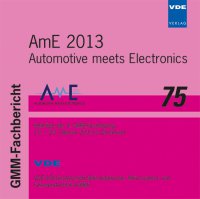New Reliability Testing Methods for Electromobility Applications
Conference: AmE 2013 - 4. GMM-Fachtagung
02/19/2013 - 02/20/2013 at Dortmund, Deutschland
Proceedings: AmE 2013
Pages: 6Language: englishTyp: PDF
Personal VDE Members are entitled to a 10% discount on this title
Authors:
Otto, Alexander; Michel, Bernd; Rzepka, Sven (Fraunhofer ENAS, Micro Materials Center, Chemnitz, Germany)
Matkowski, Przemyslaw (Wroclaw University of Technology, Wroclaw, Poland)
Brabandt, Ines (Amitronics Angewandte Mikromechatronik GmbH, Seefeld b. München, Germany)
Winkler, Thomas (Berliner Nanotest und Design GmbH, Berlin, Germany)
Abstract:
Current developments towards the electrification of transport are focusing on the energy storage and the overall drive train systems in terms of performance, efficiency, and costs. In the course of this trend, smart electronic systems are gaining more and more importance, e.g. to perform dedicated controlling and monitoring tasks, to communicate with other instances, or even to harvest energy from the surrounding environment. Moreover, smart systems are becoming essential parts of safety related blocks like battery management system (BMS), which must prevent the lithium-based energy storage cells from ever coming in a critical situation (thermal runaway), or the motor control units realizing true torque vectoring. Hence, the reliability of the smart systems is of utmost concern. The high safety level needs to be maintained over the whole lifetime of the vehicle. In order to meet the challenge of growing requirements, new test methods are needed for assessing the reliability of future products efficiently yet comprehensively. The paper presents new approaches to accelerated reliability tests on electronic systems by combining different load factors simultaneously. This way, the test duration can be reduced as compared to sequential schemes. In addition, the effects arising from the combination of different loads are also taken into account while they cannot be considered so far. Thus, the combined tests match real life conditions better. First tests under combined loads have been performed on different test vehicles and solder joints. The results are discussed in detail.


